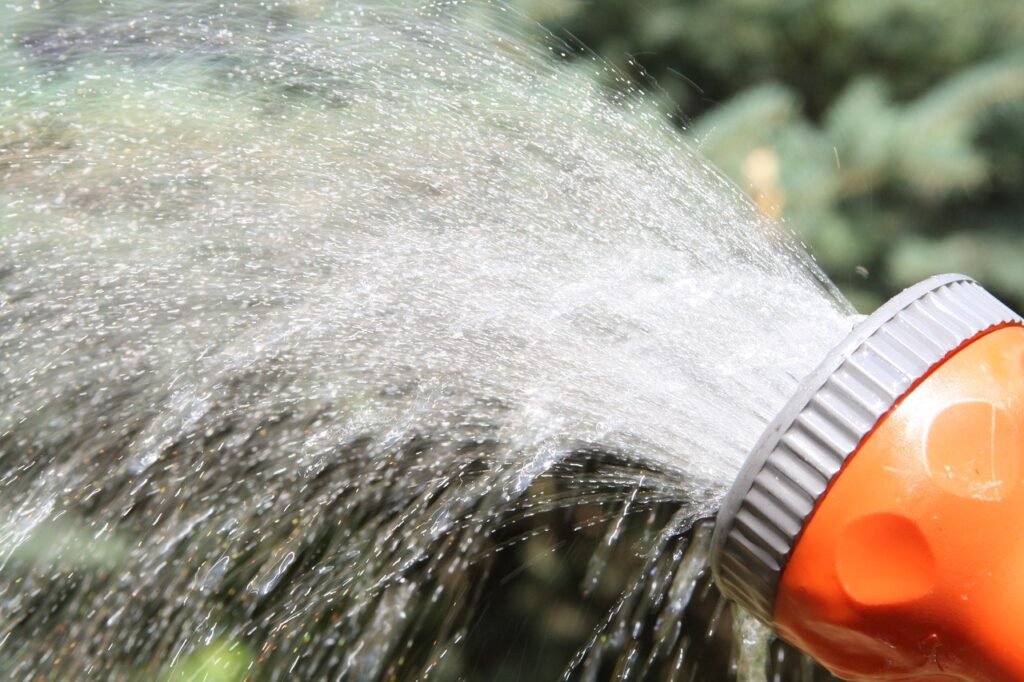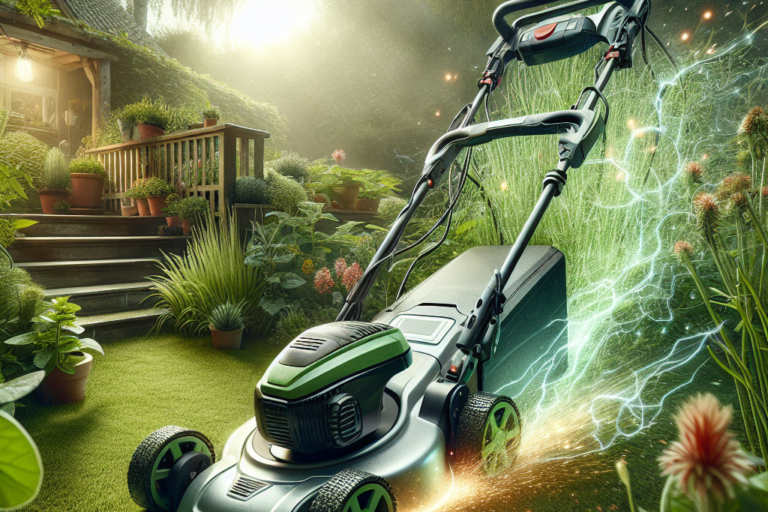If you’re wondering how much water to use when irrigating your lawn, look no further. In this article, we’ll uncover the perfect amount of water needed to keep your lawn healthy and vibrant. From understanding the type of grass you have to factors like weather conditions and soil type, we’ll explore everything you need to know to ensure your lawn gets the right dose of hydration. Get ready to become an expert on the ideal water usage for a lush and thriving lawn.

Factors to consider for determining the right amount of water
Climate
The climate in which you live plays a crucial role in determining the amount of water your lawn needs. In hot and dry climates, such as arid regions or desert areas, grass requires more water to survive and thrive. On the other hand, if you reside in a cooler and wetter climate, your lawn may require less water. Understanding the specific climate patterns in your area will help you adjust your watering schedule accordingly.
Type of grass
Different types of grass have varying water requirements. Warm-season grasses, like Bermuda grass or Zoysia grass, generally have higher water needs compared to cool-season grasses such as Kentucky bluegrass or fescue. It is essential to identify the type of grass you have in your lawn and research its specific watering needs. This way, you can avoid overwatering or underwatering, ensuring your grass stays healthy and vibrant.
Soil type
The type of soil in your lawn also affects the water requirements. Sandy soils drain water quickly and can dry out faster, requiring more frequent irrigation. Meanwhile, clay soils retain water longer and may not need watering as often. Understanding the soil composition in your lawn will help you determine the appropriate watering schedule and avoid water wastage.
Time of year
The time of year is another critical factor to consider when determining the right amount of water for your lawn. During the hot summer months, your grass will require more water to maintain its green color and sustain growth. However, during cooler seasons or periods of rain, your lawn may need less frequent watering. Adjusting your irrigation schedule based on the time of year ensures your lawn receives the right amount of water it needs at any given time.
Calculating the water needs for your lawn
Determining evapotranspiration rate
Evapotranspiration rate is the amount of water lost from the soil through evaporation and plant transpiration. It is an important factor in calculating the water needs of your lawn. Several online resources and local extension offices provide evapotranspiration rate data specific to your area, allowing you to determine how much water your lawn loses daily. This information helps you estimate the amount of water required to replenish what is lost.
Determining lawn’s water requirement
Once you know the evapotranspiration rate, you can determine your lawn’s water requirement. This can be calculated by multiplying the evapotranspiration rate by the grass’s water requirement factor, which varies depending on the type of grass you have. By considering both the climate and type of grass, you can accurately calculate how much water your lawn needs to stay healthy and vibrant.
Calculating irrigation time
To calculate the irrigation time, you need to know how much water your sprinkler system delivers per minute. You can measure this by placing several empty tuna cans or plastic containers throughout your lawn and running the sprinklers for a specific duration. Measure the depth of water collected in the containers and calculate the average. Once you have the average, you can determine the irrigation time required to deliver the appropriate amount of water based on your lawn’s water requirement.
Efficient watering techniques
Watering deeply and infrequently
Watering deeply and infrequently promotes healthy root growth and enhances the drought resistance of your lawn. Instead of frequent shallow watering, which encourages the grass roots to stay near the surface, deep watering encourages the roots to grow deeper into the soil. This method helps the grass draw moisture from deeper soil layers, making it more resilient during periods of dry weather.
Watering during the early morning
Watering your lawn during the early morning hours is the most efficient time to provide water to your grass. The cooler temperatures and lower wind speeds reduce evaporation, allowing the water to penetrate the soil effectively. Watering early in the day also allows the grass blades to dry before evening, minimizing the risk of disease or fungus development.
Avoiding water runoff
Overwatering can result in water runoff, which not only wastes water but also leads to nutrient runoff and potential environmental contamination. To prevent water runoff, water your lawn in shorter cycles, allowing time for the water to penetrate the soil before resuming irrigation. This technique ensures that your grass receives adequate hydration without wasting water.
Using sprinklers with proper coverage
Ensuring your sprinklers provide proper coverage is essential to water your lawn evenly. Make sure that the sprinkler heads are not blocked or obstructed, preventing water from reaching specific areas. Adjust the sprinkler spray patterns to avoid watering sidewalks, driveways, or other non-garden areas. Proper coverage ensures that every part of your lawn receives an equal amount of water, promoting uniform growth and reducing the risk of dry or patchy areas.
Methods for measuring water usage
Rain gauge
A rain gauge is a simple and effective tool for measuring the amount of water your lawn receives from rainfall. It consists of a cylinder or tube that collects and measures the water. Place the rain gauge in an open area of your lawn, away from any obstructions that could affect the accuracy of the measurements. Regularly check and empty the rain gauge after rainfall to track how much water your lawn has received.
Tuna can or plastic container method
The tuna can or plastic container method is a practical and affordable way to measure the water delivered by your sprinkler system. Place several empty tuna cans or plastic containers throughout your lawn before running the sprinklers. After a specific duration, measure the depth of water collected in each container and calculate the average. This method provides valuable insight into how much water your sprinklers are delivering and helps adjust your irrigation schedule accordingly.
Moisture meters
Moisture meters are handy devices that measure the moisture content of the soil. These devices typically have prongs or sensors that are inserted into the ground to determine the soil’s moisture levels. By using a moisture meter, you can accurately monitor the level of moisture in your lawn’s soil and water accordingly. This helps prevent overwatering or underwatering, resulting in a healthier and more water-efficient lawn.
Smart irrigation systems
Smart irrigation systems are advanced technological solutions that use weather data, evapotranspiration rates, and other variables to determine the optimal watering schedule for your lawn. These systems can adjust the irrigation duration and frequency based on real-time weather conditions, ensuring your lawn receives the right amount of water at the right time. Smart irrigation systems can significantly enhance water efficiency and take the guesswork out of lawn watering.

Signs of overwatering or underwatering
Yellowing or browning of grass
Yellowing or browning grass blades can be a sign of both overwatering and underwatering. Overwatering leads to shallow root growth and inadequate oxygen in the soil, causing the grass to turn yellow or brown. Underwatering, on the other hand, deprives the grass of essential moisture, causing it to dry out and lose its lush green color. Pay attention to the condition of your lawn’s grass blades to determine if you need to adjust your watering practices.
Excessive thatch buildup
Thatch is a layer of dead grass and plant material that accumulates on the soil surface. Excessive thatch buildup can indicate overwatering, as it hinders the decomposition of organic matter and prevents water from penetrating the soil. Overwatering encourages the growth of thatch, which can lead to a host of other lawn problems. Regularly monitor your lawn for excessive thatch and reduce watering if necessary to prevent its buildup.
Fungus or disease development
Overwatering creates a favorable environment for fungus and disease to thrive in your lawn. Excess moisture can contribute to the development of fungal diseases, such as brown patch or dollar spot. If you notice unusual patches, spots, or discoloration on your lawn, it may be a sign of overwatering. Adjust your watering schedule and practices to prevent the occurrence and spread of lawn diseases.
Weeds or shallow root growth
Overwatering can promote the growth of weeds, as many weeds thrive in moist conditions. Additionally, overwatering leads to shallow root growth in your grass, making it more susceptible to weed infestation. If you notice an abundance of weeds in your lawn or shallow root growth in your grass, it may be an indication that you are overwatering. Proper watering practices will help control weed growth and encourage healthier root development in your grass.
Water conservation practices
Reduce grass area
Reducing the size of your grass area is an effective way to conserve water. Consider replacing some areas of your lawn with native plants, ground covers, or mulched beds. These alternatives often require less water than traditional grass lawns, reducing your overall water consumption. Additionally, reducing the grass area can lower your maintenance efforts and create a more sustainable and environmentally-friendly landscape.
Improve soil quality
Improving the quality of your soil can significantly impact water conservation. Amending the soil with organic matter, such as compost or peat moss, can enhance its water-holding capacity and reduce water runoff. Healthy soil retains moisture more effectively, reducing the need for frequent watering. Conduct a soil test to determine the specific requirements of your soil and make necessary amendments to improve its quality.
Utilize mulch
Mulch provides a variety of benefits, including water conservation. Applying a layer of organic mulch around your plants and in garden beds helps retain soil moisture and prevents water evaporation. Mulch acts as a barrier against the sun’s heat, reducing moisture loss and keeping the soil cooler during hot days. Using mulch not only conserves water but also suppresses weed growth and enhances the overall health of your landscape.
Capture and reuse rainwater
Harnessing and reusing rainwater is an excellent way to conserve water and reduce your reliance on municipal water sources. Install rain barrels or cisterns to collect rainwater from your roof, which can then be used for watering your lawn and garden. Rainwater is free of chemicals found in tap water, making it an ideal and sustainable water source for your plants. Utilizing rainwater also helps mitigate stormwater runoff and reduces the strain on local water supplies.

Tips for water-efficient lawn care
Mow at the proper height
Mowing your lawn at the proper height is crucial for water efficiency. Cutting your grass too short can expose the soil to excessive sunlight, increasing evaporation and water loss. Conversely, letting your grass grow too long can create shade and retain moisture, promoting fungal diseases. Research the recommended mowing height for your specific type of grass and adjust your mower accordingly. Maintaining the proper mowing height ensures proper water usage and promotes a healthy lawn.
Don’t over-fertilize
Applying excessive amounts of fertilizer can lead to excessive growth and increased water requirements for your lawn. Over-fertilization can cause your grass to become lush and dense, requiring more water to support its growth. Follow the recommended fertilization guidelines for your specific type of grass and avoid over-application. Properly fertilized grass will have healthier root systems, allowing for more efficient water usage.
Aerate the lawn
Aerating your lawn is an essential practice to promote water penetration and reduce water runoff. Over time, soil can become compacted, hindering water absorption and root growth. By regularly aerating your lawn, you create channels in the soil that allow water to reach the grass roots more effectively. This encourages deeper root growth and reduces the need for excessive watering. Aeration also helps alleviate thatch buildup and enhances soil health.
Control weeds
Weeds compete with your grass for water and nutrients, making it essential to control their growth. Weeds can significantly impact the water needs of your lawn, as they draw moisture away from the grass. Implement proper weed control measures, such as pulling weeds manually or using herbicides, to prevent them from draining water from your lawn. By reducing weed growth, you can optimize your water usage and ensure your grass receives the necessary hydration.
Adjusting water usage based on rainfall
Monitoring weather forecasts
Keeping an eye on weather forecasts will help you adjust your watering schedule based on predicted rainfall. If rainfall is expected, you can delay or skip your irrigation to avoid overwatering. By monitoring the weather, you can optimize your water usage and conserve water by taking advantage of natural rainfall.
Rain shutoff devices or sensors
Installing rain shutoff devices or sensors can automatically adjust your sprinkler system based on rainfall. These devices detect rainfall and prevent the irrigation system from activating if there is sufficient moisture. Rain shutoff devices ensure that your lawn receives water only when needed, reducing water waste and promoting water conservation.
Manual adjustment during rainy periods
Even with rain shutoff devices, it is essential to manually adjust your watering schedule during rainy periods. Heavy or prolonged rainfall can saturate the soil, making additional irrigation unnecessary. Monitor the condition of your lawn and adjust your irrigation accordingly. By manually adjusting your watering practices, you can avoid overwatering and ensure efficient water usage.

Watering restrictions and regulations
Check local guidelines
Many regions have specific watering restrictions and regulations in place to conserve water and manage resources effectively. It is important to familiarize yourself with the local guidelines to avoid any penalties or fines. Check with your local water utility or municipality to determine the specific watering days, time restrictions, or limits on water usage in your area.
Observe designated watering days
In areas with watering restrictions, it is crucial to observe the designated watering days. These restrictions are typically in place to manage water demand and promote conservation. Adhering to the assigned watering days ensures that you use water efficiently and in compliance with local regulations. Consider implementing water-saving techniques, such as deep watering, during the allotted watering days to maximize the effects of limited water usage.
Explore alternative water sources
In regions where water resources are limited, exploring alternative water sources can help you sustain your lawn without overtaxing the local supply. Consider installing a greywater system to reuse water from sinks, showers, or washing machines for irrigation purposes. Additionally, harvesting and utilizing rainwater through rain barrels or cisterns can provide a supplementary water source for your lawn. Exploring these alternative water sources demonstrates your commitment to water conservation and reduces the strain on the environment.
Conclusion
Determining the right amount of water to use when irrigating your lawn is essential for maintaining a healthy, vibrant, and water-efficient landscape. By considering factors such as climate, grass type, soil type, and time of year, you can accurately calculate your lawn’s water requirements. Implementing efficient watering techniques, using appropriate measurement methods, and monitoring signs of overwatering or underwatering will help you conserve water and promote a sustainable lawn. By integrating water conservation practices, following water-efficient lawn care tips, adjusting water usage based on rainfall, and adhering to any watering restrictions or regulations, you can contribute to a greener and more environmentally conscious community.



